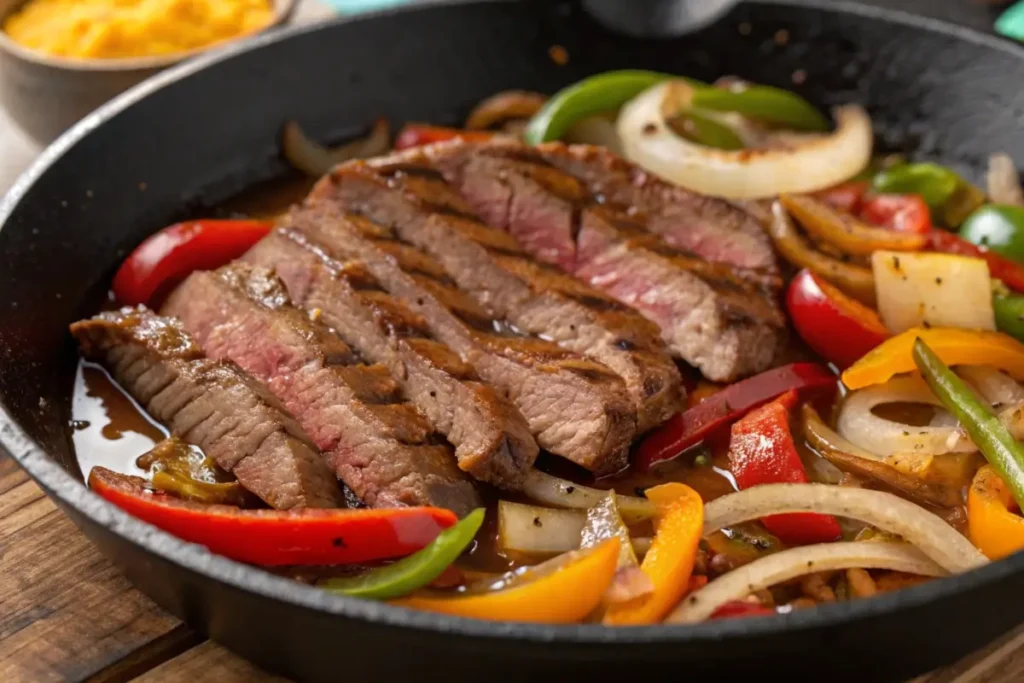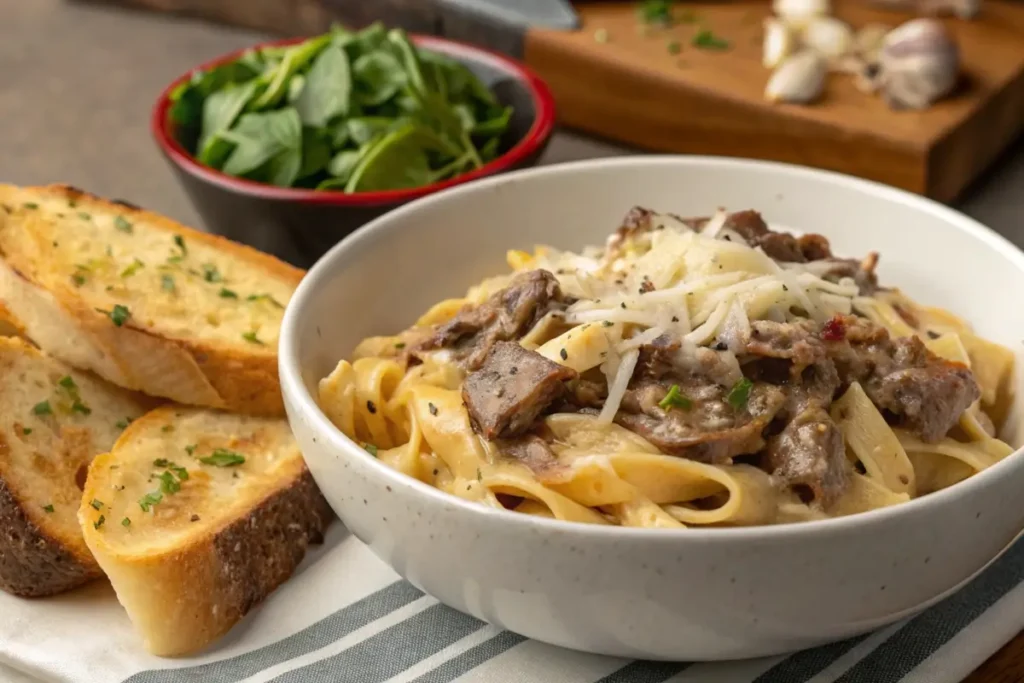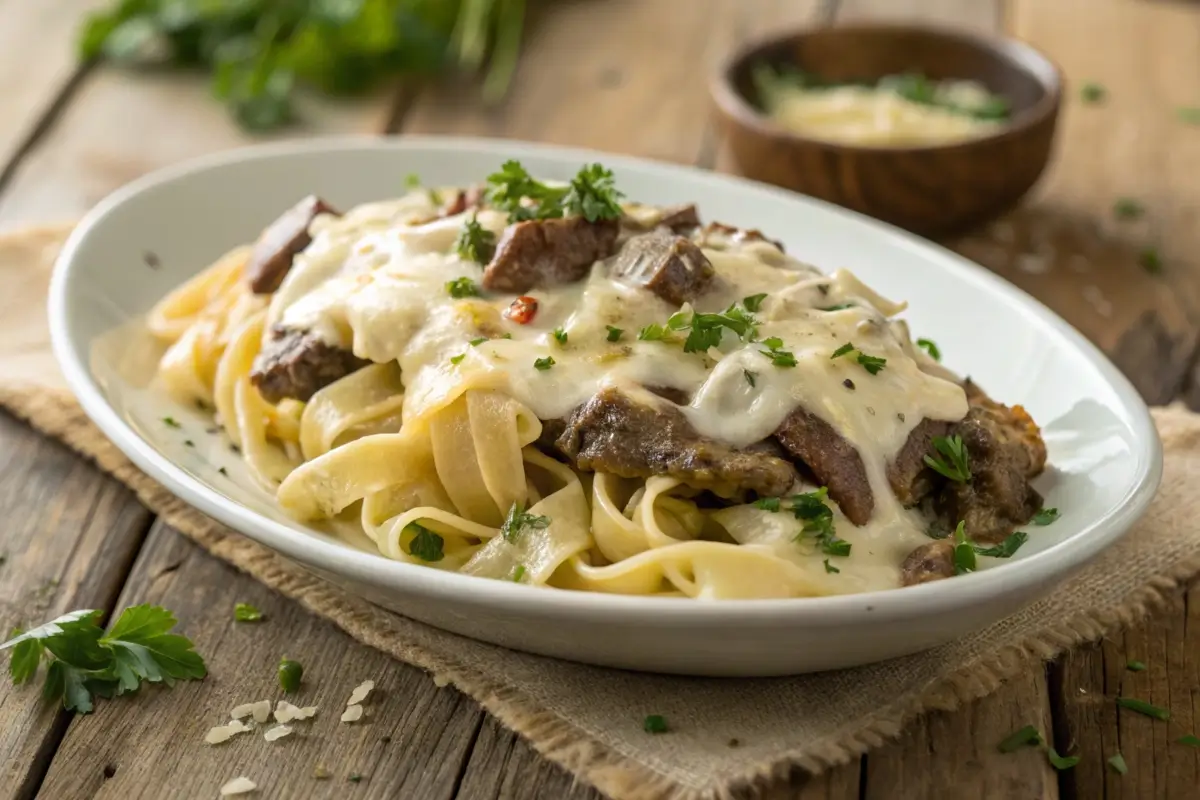When you think of comfort food, what comes to mind? Maybe gooey mac and cheese or a big bowl of spaghetti. But have you ever tried Philly Cheesesteak Pasta? If not, you’re in for a treat! This dish combines the classic flavors of a Philly cheesesteak sandwich with the heartiness of pasta. Imagine pasta smothered in cheese, topped with tender steak, and infused with the wonderful taste of sautéed onions and peppers. Sounds delicious, right? Let’s dive deep into this fantastic recipe, why it’s a win for any meal, and how to make it perfect every time!
What is Philly Cheesesteak Pasta?
Let’s start at the beginning. What exactly is Philly Cheesesteak Pasta? Well, it’s a creative twist on the iconic Philly cheesesteak sandwich—a dish that originated in Philadelphia, Pennsylvania. Traditionally, this sandwich is made with thinly sliced steak, sautéed onions, and melted cheese served on a hoagie roll. But when you transform those yummy ingredients into a pasta dish, magic happens!
It’s a delightful medley of flavors and textures. You get the cheesy goodness, the savoriness of the steak, and the comforting form of pasta all mixed into one delicious bowl. If you’ve ever tried to decide between pasta or a cheesesteak for dinner, this dish wonderfully combines the two!
Origins of the Philly Cheesesteak
Before we get cooking, it’s fun to know where this yummy dish comes from. The cheesesteak was invented in the 1930s by a couple of brothers, Pat and Harry Olivieri. They whipped up a delicious sandwich made from grilled steak and onions, served in a roll. It exploded in popularity, and soon the cheesesteak became a Philly staple.
Fast forward to today, and the cheesesteak craze has led to endless recipes, including the famous Philly Cheesesteak Pasta. It’s like bringing the streets of Philly right into your kitchen!
The Evolution into Pasta
As food lovers began experimenting, swapping out bread for pasta made sense. After all, who doesn’t love pasta? It provides a perfect base for a variety of flavors. By combining the cheesesteak’s classic ingredients with pasta, cooks created a unique dish that’s simple to make and bursting with flavor. You know what they say: if it ain’t broke, don’t fix it, but if it can be made even better—why not?
Why You Should Try Philly Cheesesteak Pasta
A Unique Flavor Combination
You might be thinking, “How can something so simple taste so good?” Well, it’s all about that perfect flavor combination. Picture this: succulent, juicy steak, sweet sautéed onions, vibrant bell peppers, and ooey-gooey cheese—all wrapped up in a comforting blanket of pasta. Each ingredient complements the other beautifully, creating an explosion of flavor in every bite. It’s like a flavor party in your mouth!
Perfect for Any Occasion
Whether you’re serving dinner to your family after a long day or hosting friends for a movie night, Philly Cheesesteak Pasta hits the spot. It’s an easy one-pot dish that can be ready in no time. Plus, it’s impressive enough to wow your friends but simple enough for a weeknight meal. You’ll find everyone asking for seconds!
Ingredients for Delicious Philly Cheesesteak Pasta
Now that we’ve stirred up your appetite, let’s talk ingredients. For cooking, it’s super crucial to gather everything you need. You wouldn’t want to start cooking just to find you’re missing something, right?
Essential Ingredients for Cheesesteak Pasta
Here’s the breakdown of what you’ll need to bring this dish to life (feel free to write these down or print them out):
| Ingredients | Quantities |
|---|---|
| Pasta (penne or rotini) | 12 oz (340g) |
| Ribeye steak | 1 lb (450g) |
| Onion | 1 medium, sliced |
| Bell pepper | 1, sliced (any color) |
| Garlic | 2 cloves, minced |
| Cream cheese | 4 oz (115g) |
| Shredded provolone cheese | 1 cup (100g) |
| Olive oil | 2 tablespoons |
| Salt and pepper | To taste |
| Italian seasoning | 1 teaspoon |
| Beef broth | 1 cup (240ml) |
Flavor-Packed Additions to Enhance Your Dish
Feel free to get creative! You could toss in some mushrooms or even jalapeños for a spicy kick. Want it cheesier? Add more cheese! Here are some optional add-ons to consider:
- Mushrooms: 1 cup, sliced
- Jalapeños: 1, thinly sliced (for that spicy kick)
- Parmesan Cheese: ¼ cup for garnish
With all this deliciousness lined up, you’re already on your way to making something fantastic!
Step-by-Step Cooking Instructions
Alright, it’s time to put on those aprons and get cooking. Don’t worry; I’ll guide you through each step.
Preparing the Steak
- Slice the Steak: Start by slicing your ribeye steak against the grain into thin strips. This helps ensure it’s tender when you cook it. If you’re unsure how to do it right, just imagine cutting it like paper. You want those thin slices that will cook quickly.
- Season It Up: In a bowl, toss your sliced steak with salt, pepper, and Italian seasoning. This simple seasoning packs a flavor punch that will make the steak sing on the plate!
Cooking the Pasta
- Boil the Pasta: Boil a large pot of salted water. Once it’s bubbling, add in your pasta. Cook it al dente—this means it should still have a slight bite to it. Follow package instructions, usually around 8-10 minutes.
- Drain and Set Aside: When the pasta is ready, drain it but save about a cup of the pasta water. This starchy water will help make the sauce creamy later!
Combining and Serving the Dish
Now comes the magic part!
- Sauté the Vegetables: In a large skillet over medium-high heat, add olive oil. Toss in the sliced onions and bell peppers. Sauté for about 5-7 minutes until they’re soft and slightly caramelized. This process brings out their natural sweetness!
- Add the Steak: Push the veggies to the side of the pan, and add your seasoned steak to the skillet. Cook until the steak is browned, about 3-5 minutes, stirring occasionally.
- Incorporate Garlic: Add the minced garlic to the skillet and cook for an additional 1-2 minutes. The aroma will be incredible!
- Mix in Cheese and Sauce: Lower the heat and add cream cheese, stirring until it’s melted and combined. Then pour in the beef broth. Stir everything together, and if it seems a bit thick, add some reserved pasta water until you reach your desired consistency.
- Toss the Pasta: Finally, add the drained pasta to the skillet. Toss it well until everything is coated in that cheesy goodness.
- Serve It Up: Plate your Philly Cheesesteak Pasta and sprinkle with shredded provolone cheese. If you’re feeling fancy, top with fresh parsley for color. And there you have it—dinner is served!
“Cooking is like love. It should be entered into with abandon or not at all.” —Julia Child
Common Problems When Making Philly Cheesesteak Pasta
Even with the best intentions, sometimes things go awry in the kitchen. Don’t fret! Let’s tackle some common issues you might face when whipping up this dish.
Undercooked or Overcooked Pasta
Ever been there? You’re cooking pasta, and it just doesn’t feel right. Undercooked pasta is chewy, while overcooked pasta turns mushy. The key here is to monitor it closely—taste a piece a minute or two before the package says it should be ready. That al dente bite makes all the difference!
Too Much Liquid in the Sauce
If your sauce ends up soupy, it can drown your pasta. No one wants that! But if this happens, just let it simmer a bit longer to reduce the excess liquid. And remember, you can always add more cheese to thicken it up!
Steak Not Tender Enough
Nobody enjoys tough steak, right? Make sure to slice against the grain and consider marinating your steak for a couple of hours before cooking. A simple marinade of olive oil, vinegar, and some seasonings can work wonders for tenderness.
Solutions to Common Cooking Issues
Cooking is all about problem-solving, and with Philly Cheesesteak Pasta, it’s no different. Let’s explore some easy solutions to those tricky problems we just talked about.
How to Perfectly Cook Pasta
To ensure your pasta emerges perfectly cooked every time, remember a few golden rules:
- Salt the Water: It should taste like the sea! Salt is vital as it enhances flavor right from the start.
- Stir Occasionally: Give it a stir while it cooks. This prevents it from sticking to the pot.
- Taste Test: As mentioned earlier, taste a piece slightly before the suggested time on the package. It should be firm yet tender.
- Reserve Pasta Water: Always save some cooking water. That starchy liquid can be a lifesaver if your sauce is too thick.
Balancing the Sauce Consistency
Did your sauce turn out too watery? No worries! Here’s how to salvage it:
- Simmer: Let the sauce simmer on low heat to reduce and thicken.
- Add Cheese: Stir in more cream cheese or even some shredded cheese. It not only thickens the sauce but also enhances the flavor.
If it’s too thick, gradually add in small amounts of reserved pasta water until you’ve reached your desired consistency.
Tenderizing the Steak
Tough steak can be a disappointment, but these hacks can help soften it up:
- Marinate: Before cooking, marinate your steak in a mixture of olive oil, vinegar, and your favorite seasonings for at least 30 minutes. Acid helps break down tough fibers.
- Slice Properly: Always slice your steak against the grain. This action shortens the muscle fibers, making each bite more tender.
- Use a Meat Mallet: If all else fails, gently pound your steak with a meat mallet to tenderize it before cooking. Just be careful not to go overboard—you don’t want a steak smoothie!
Tips for Meal Prep and Storage
Speaking of leftovers, Philly Cheesesteak Pasta can last a few days in the fridge. Here are some helpful tips for meal prep:
How to Store Leftovers Properly
- Cool Down: Allow the pasta to cool down to room temperature before storing.
- Use Airtight Containers: Transfer the leftovers to an airtight container. This helps keep it fresh and prevents it from absorbing other odors in the fridge.
- Slicing Portions: If you anticipate a few meals, consider portioning them out in separate containers for easy grab-and-go meals!
Reheating without Losing Flavor
The last thing you want is sad, dry pasta when reheating. Here’s how to bring it back to life:
- Stovetop Method: Heat a skillet on low and add a splash of beef broth or reserved pasta water. Stir in the leftovers until warmed through. The added liquid helps create a saucy consistency again.
- Microwave Method: Place your pasta in a microwave-safe dish and add a few tablespoons of broth or water. Cover it with a microwave-safe lid or plastic wrap with a few holes punched in it (to let steam escape). Heat in short intervals, stirring in between until fully warmed.
Creative Variations of Philly Cheesesteak Pasta
One of the best aspects of cooking is experimenting! There are so many ways to mix it up with this dish. Here are a couple of fun variations you can try.
Vegetarian Alternatives
Who says you need steak to make it flavorful? For a vegetarian take:
- Use Portobello Mushrooms: They have a meaty texture that can replace steak wonderfully. Just sauté them until golden and follow the same steps.
- Add Tofu: Firm tofu, when marinated and sautéed, can absorb flavors like a sponge. Chop it into cubes and cook it until crispy!

Gluten-Free Options
If gluten’s not your friend, don’t worry! Here’s how to swap it out:
- Use Gluten-Free Pasta: There are tons of gluten-free options available these days. Follow the same cooking instructions, but keep an eye on the cooking time.
- Quinoa or Zucchini Noodles: For something different, consider using quinoa or spiralized zucchini for a lighter dish. They can add a nutritious twist while keeping the spirit of the dish alive!
Pairing Suggestions
Now you’ve got your delicious Philly Cheesesteak Pasta ready; let’s talk about perfect pairings.
Ideal Side Dishes
To complement your main dish, consider these scrumptious side ideas:
- Garlic Bread: Can you ever say no to toasted bread slathered in garlic butter? Absolutely not!
- Green Salad: A fresh salad with spinach, cherry tomatoes, cucumbers, and a light vinaigrette can add a refreshing crunch to your meal, balancing out the richness of the pasta.
- Coleslaw: A creamy, crunchy coleslaw can provide a delightful contrast to the meal’s warm, cheesy flavors.

Drink Pairings for Your Meal
Enhance the dining experience with these enjoyable drink options:
- Soda: Classic cola or lemon-lime soda can be the right balance to the savory pasta.
- Iced Tea: A refreshing glass of iced tea—sweetened or unsweetened—can cool off the spices and add a touch of summer.
- Craft Beer: If you’re of age, a local craft beer can be an excellent pairing for this hearty dish. The hops can cut through the richness and complement the flavors beautifully.
Frequently Asked Questions about Philly Cheesesteak Pasta
Alright, before we wrap things up, let’s tackle some common questions about Philly Cheesesteak Pasta.
Can I use a different type of cheese?
Absolutely! While provolone is traditional, don’t be shy about experimenting. Cheddar, mozzarella, or even pepper jack for extra spice can all add their unique flavors.
How can I make it spicier?
If you like a kick, consider adding diced jalapeños when sautéing the onions and peppers. A sprinkle of red pepper flakes or a dash of hot sauce can also do the trick.
Conclusion: Why Philly Cheesesteak Pasta is a Must-Try!
Philly Cheesesteak Pasta is truly a revelation. It combines the classic elements of a beloved sandwich into a comforting pasta dish that’s sure to impress. Whether you’re a picky eater or a food adventurer, this dish has something for everyone.
So, the next time you’re pondering what to make for dinner or hosting a gathering, don’t forget this magnificent recipe. With easy steps, endless variations, and mouthwatering flavors, you’ll keep coming back for more. Plus, let’s be honest: cheese, steak, and pasta? What’s not to love!
Now it’s your turn! Are you ready to roll up your sleeves and create this mealtime masterpiece? Trust me; you won’t regret it!

